All you need to know about your products!

| 3DNews Vendor Reference English Resource - All you need to know about your products! |
||||||
 |
||||||
|
|
||||||
CeBIT`2004: Expo Coverage - SpireAuthor:Date: 02/04/2004 Since all the CeBit'2004 is somehow about migration to new platforms, it's difficult to browse around expo stands without a prior lead-in to new T's (or, technologies abbreviated by Greg Barret). IT T`s 2004
For 2004, Intel prepared a true technology revolution indeed. The Socket 478, DDR memory and the AGP bus, so customary and kin, will become a thing of the past. The internals of the modern platform are radically changing. We will have to get used to new names, abbreviations, technologies and product design. Somehow or other, we'll be talking about the new chipsets - Alderwood (coming to take the place of i875) and Grantsdale P/G (a replacement for i865P/G) which simply flooded the expo. Simply put, their unofficial announcement has already taken place. But officially the chipsets haven't yet been announced, and in this review we'll be using only their code names, and their marketing names are longer a secret. Motherboard manufacturers mention very different dates for announcing new chipsets - from late April, as optimists put it, to late June, as per pessimists. Let's hope by Computex (1-5 June) or during the event the official announcement will anyway take place. Too many companies are involved in migrating the industry to new ways, and if Intel lets ATI and NVIDIA down with the dates of introducing the PCI-ex bus, the guys will be seriously upset.. Because their today's graphic cores are already designed just for the new bus. And that's only the tip of the iceberg. Socket LGA775So, in both of the anticipated chipsets, support for the new processor socket, LGA775, is already integrated. Today's Socket 478 is already outdated, so are first Prescott processors which turned outdated immediately on their release (the same is about the first Athlon 64 processors, so fans of both companies products ought not to mock about each other). 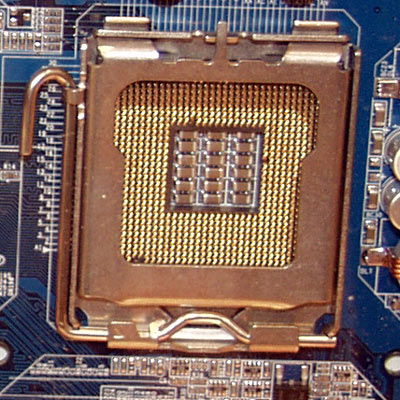 At the expo, the new socket on all boards is covered with a lid like that At performance, today's Prescotts can't compete with the good old Northwood at the same clock speeds. The 31st stage of pipeline as compared to the 20th can't be made up for with increased cache size and improved branch processing mechanism. Even more, the NetBurst architecture in the new processor hasn't undergone essential changes. The essence of Prescott is in that allows for further smooth rise of CPU clock speeds to 5-7 GHz, but it will lose to Northwood at today's clock speeds in most applications, especially games. The same occurred with the release of the first P4 processor which at 1.4 GHz lagged well behind PIII 1.33 GHz. Today's parity will set in at approximately 3.6, and then it will increasingly win :). So what were the reasons for changing the socket and increasing the number of pins? First of all, the need for the "right" and uniform application of voltage to specific areas of the chip. Even today's Prescotts consume 90-100W less power, which is as much as a light bulb eats. To protect the processor against blazing up and melting - a minimum of power is applied to each of its sector, and as the process technology grows diminutive (Prescott is the first to be made following the 0.09 mk process) the area of these sectors shrink as well. With the increase in the total number of transistors on the chip, more pins are needed to feed all the sectors of the chip. Today's new socket, as per the expert opinion, may live for about 3-4 years, and then transition to a new chip package is inevitable. DDR IIJust another technology accompanied by most fantasies and rumors. Yes, the first generation DDR has exhausted its potential to the full, and its further progress is impossible. Our test that we ran half a year ago, Memory for the overcloker vividly showed that DDR in its current form wouldn't give any system performance boost whatever you do with it, since general latency timings increase thus eating up all the clock speed gains. DDR has died, in the sense that it has come up against its technological limit. DDR500, DDR533, DDR550... these are all monkey tricks... JEDEC is not their equal, although it's fun tampering around sometimes ;-) 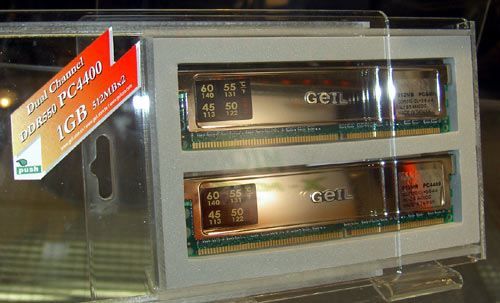 DDR550 by Geil The start of DDRII will begin from 400 and 533 MHz. It's just these frequencies that are supported by Alderwood and Grantsdale. 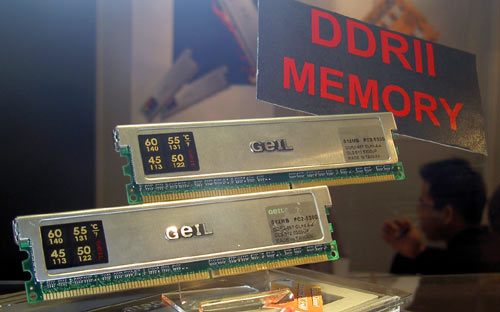 DDRII-667 Сl=4:4:4 by Geil As we see, the guys at Geil, faithful to their slogan "Always Ahead", have gone a bit too far with the frequency. In fact, both Alderwood and Grantsdale support regular DDR as well, which is very nice. Another thing is that Intel claims about the fundamental impossibility to place both versions onboard at the same time, and manufacturers will have to choose something between the two. "But.. if those tricky Taiwanese invent something...", as a representative of Intel said to us still in Moscow. Looks like invent they did: 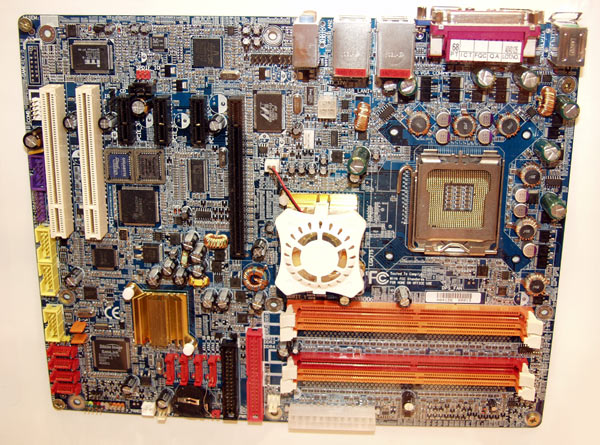 GIGABYTE 8GPNXP-DUO (Grantsdale P) 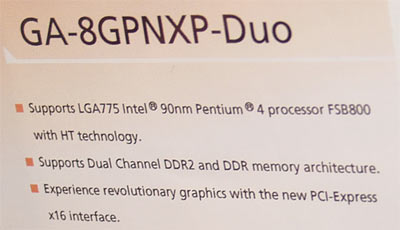
For now, only Gigabyte presented a motherboard that offers simultaneous support for these two standards, that is, it is possible on principle, and therefore we are in for numerous announcements of such produce. But at the moment at the expo we saw solely DDRII is placed on the high-end Alderwood, with the DDR on the simpler Grantsdale. Again this marketing...  Corsair XMS2 (DDRII) at ASUS' expo stand The theoretical limit of the DDRII architecture is somewhere between 1000 and 1400 MHz and will be exhausted in about two years. Then there will be a transition to DDR III, which is currently being tested on video cards, following the tradition. PCI-express x16A new standard of the video bus, of which almost all has been told. It's been four months already that at all the training workshops, lectures, seminars and presentations, they have explained to us at length that this support in NVIDIA solutions is arranged through a bridge for now (interpretation of AGP signals to the PCI Express with a single chip), and ATI solutions have native support for that, that is, integrated in the GPU itself. What is the difference and is it really so fundamental? Not really. There aren't any differences in modern graphic chips, and the real aid to the graphic subsystem gained from transition to a new bus will be felt in a distant future only. Both AMD/Intel's transition to new sockets and ATI/NVIDIA's transition to a new bus is merely a margin for the future. So to say, a smooth transition to new standards which are still not knocking at the door but will come soon.  "The future ATI PCI-express" at GeCube expo stand Details are not to be disclosed  GeForce PCX5300 by Sparkle Core: 250 MHz, Mem: 400 MHz, 128 DDR All the Alderwood and Grantsdale MoBo's have merely the PCI-express bus. The AGP option is impossible. Isn't that too tough? Yes.. but the return to the past is no longer possible.. if only by some alternative players :-) Interim conclusions:In the first part of the CeBIT`2004 coverage, we told about merely three major innovations of the season, but they are enough to understand how the concept of a "modern computer" will change in this year. Frankly, it's hard to grasp straight off what it fill finish with and where the industry with all its today's freaks may turn... Will Creative survive with its pretty worn sound brand once the Azalia (7.1) technology has been integrated to Intel's south bridge ICH6? Abit's three-year-old slogan "RAID for all" has finally come true... (an option of the ICH6R). Even Wi-Fi has been added as a motherboard standard feature (an option of the south bridge ICH6W). While walking around the stands, we'll touch on these technologies in more detail. For now, look into this slide: 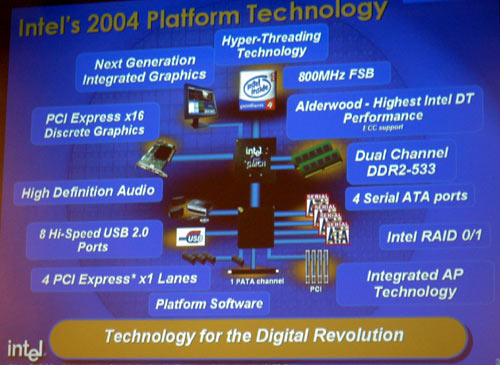
Photo of the day: "Stupid girl!"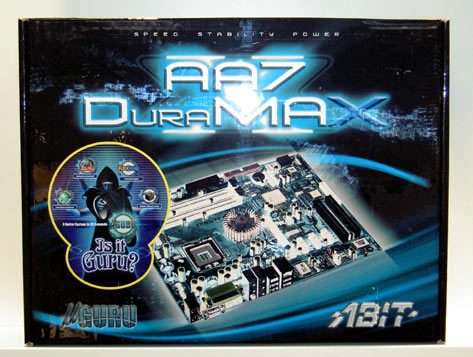
From a conversation at an expo stand: - Wow! Do you know what "Dura" means in Russian? A grandiose marketing success in the Russian-speaking environment is guaranteed! You'll know what to give you mother-in-law for her birthday :-) Gigabyte Expo StandMoBoTraditionally, we start with motherboards. Having spent all the thinkable and unthinkable fantasies onto i865/875, having released motherboards of the first and second generations, hardware manufacturers were really delighted to grab hold of the novelty of the first half of the year 2004 - the Alderwood and Grantsdale chipsets. Since some time, any innovations by SiS, ALi and ATI for P4 have been positioned by manufacturers as budget solutions, and it seems like nothing can change the situation. But with the latest chipsets by Intel, engineers and marketing people are leaning over backwards producing super-intricate solutions. VIA and NVIDIA play on a different market, and their major partner even hasn't acquired an expo stand at CeBIT this year, which is really surprising and annoying :-(. The handsome Alderwood in Gigabyte's make offers a full set of attributes typical of a new-generation Hi-end motherboard. The PCI-express x16 (forget about the AGP for good), the DDRII (dual channel, of course), the new LGA775 socket, and the wireless on the south bridge (an option of the ICH6W). Closing it all are such trifles like three PCI-x1 connectors (a future standard of expansion), Dual Power System, Gigabit LAN and 8(!) SATA connectors SATA as you can clearly see on the photo. 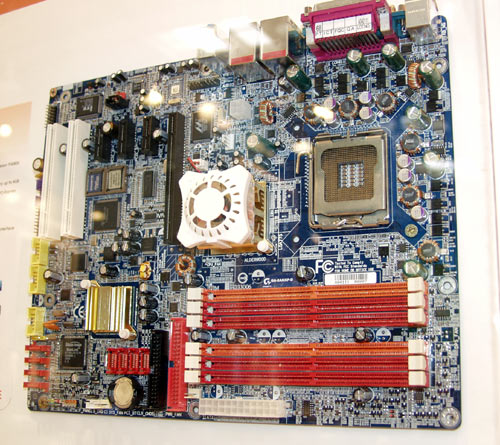 Gigabyte 8ANXP-D (Alderwood) There are two version of the new south bridge ICH6, - Hi-Wi with the W- suffix, and R- for RAID. In this case the W is chosen, and RAID is implemented with the new Silicon Image chip: 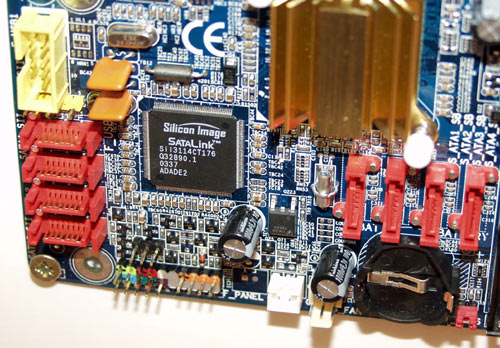
The main problem motherboard manufacturers came up against was the evident unreadiness of i875/865 boards for normal and stable operation with Prescott. You can talk as much as you like about the "full compatibility", but in reality the increased power consumption forces the motherboard to operate at the boundary zone of physical destruction. Manufacturers have had a lot of trouble dealing with boiling capacitors and drying up electrolyte... A radical remake of the whole PCB design, as well as increased power of the voltage stabilizer and a thorough approach to cooling the critical sectors (CPU socket, north and south bridges, voltage stabilizer around the socket) were needed. Coming back to the Alderwood, it makes sense noting that manufacturers are ever unlikely to equip the solutions with sockets for DDR memory, although it is possible. But only for DDRII. With Grantsdale - on the contrary, among the models to be produced prevailing will be those designed for the regular DDR (at least in this year), and only few will produce DDR II options for the Grantsdale. For now, only the solitary Grantsdale + DDR/DDRII is just at Gigabyte's expo stand: 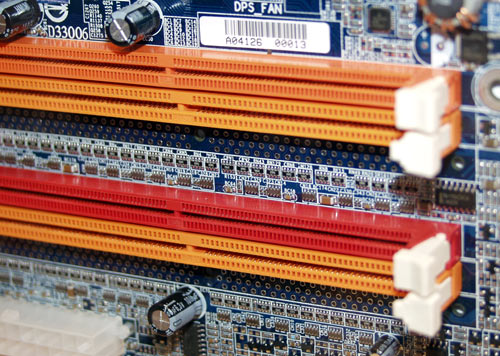 Gigabyte 8GPNXP-DUO (Grantsdale P) Note the difference in the sockets - it's impossible to fit into a wrong socket. Like in the case with its predecessor - i865, Grantsdale will be produced in the two makes - P and G. As you can easily guess, the G version will offer integrated graphics core. Other finer differences will be disclosed only upon their announcement. AMD exposed itself at Gigabyte expo stand with two new motherboards built on the nForce 3 and K8T800 chipsets, both offering support for the Socket 939 for the Athlon64 FX/Athlon64 family. 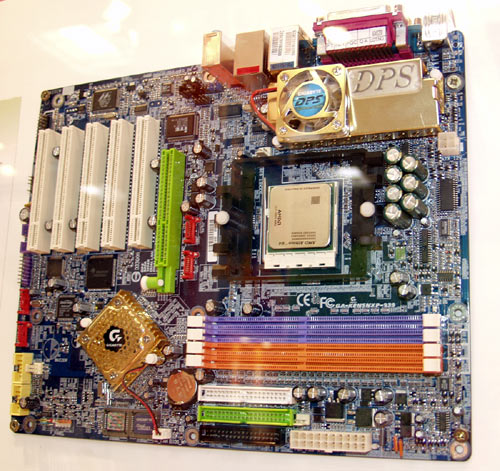 Gigabyte K8SNNXP-939 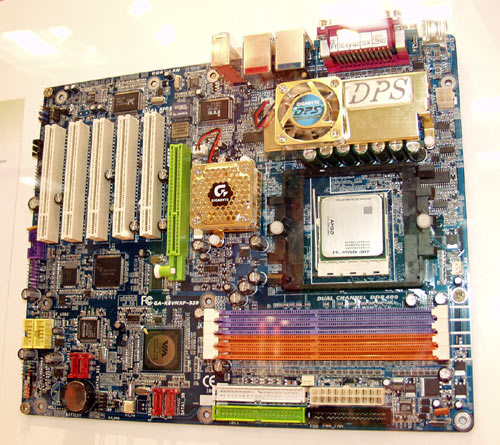 Gigabyte K8VNXP-939 VIA K8T800 Both boards offer a new version of the Dual Power System with the suffix Gold: 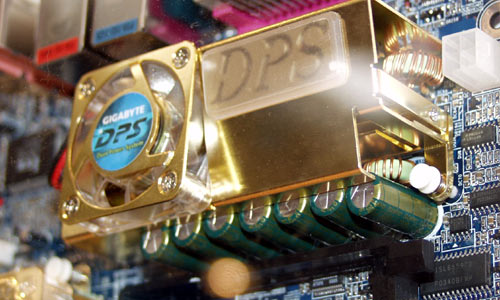 Dual Power System Gold Like in Intel's, both these chipsets offer integrated 8-channel audio codec. VGAA month ago, NVIDIA announced the PCX series of video cards that came to take the place of the FX. In fact, these are again the well-known cards, only with the additional AGP->PCI-ex bridge. To give you a complete picture, we're bringing in the full information on the product line:
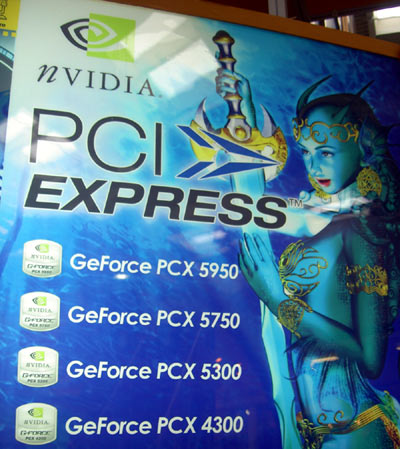
But the real clock speeds may prove to be delusive, especially in the mid-end sector. And, unlike the former times, when manufacturers were able to vary only the core and memory clock speeds, now the situation has aggravated with memory types (DDR, DDR2, DDR3), memory bit-rate (256, 128, 64) and its capacity (128Mb, 256 Mb). That is, an NVIDIA video card made by varied manufacturers may essentially differ at performance, and the user would have to consider lots of options so as not to be misled. It's nice of course for us - we've got much to do, but the buyer might get lost in the abundance of names and makes of NVIDIA's mid-end solutions. It looks like they decided to win the market with quantities :) At the expo, we acquired some "nonstandard makes" and once we are back home they will be added to our "VGA Roundup". With Hi-end cards, things are much easier. They are produced in so limited quantities that ATI and NVIDIA make them on their own and further send out to customers who will then glue their stickers on it, or maybe fit their own cooling system (which is quite rare) and pack in nice-looking boxes. Only the most favorite partners are given the courtesy to rise above the others on the VGA Hi-End market. For ATI, it is ASUS who is producing not the reference ASUS Radeon 9800XT, and for NVIDIA it is GIGABYTE producing FX5950 Ultra GT featuring the clocking rate of the core increased from 475 MHz to 520 MHz. That requires especially high-quality chips. By the way, having this card test labs may save on samples... The whole line of cards based on the NV35 is emulated easily - for that, it suffices to set the core and memory speeds in accord with FX5900, FX5900 Ultra, FX5950 Ultra, and at its base frequencies this will give the Gigabyte FX5950 Ultra GT. During tests, the results fully coincide, and that can't be any different. That is, in the luxurious sector all is more or less clear, but what is going on in the mid-end sector can be regarded as a complete mess. What is good is the fact that unlike the previous years many manufacturers started earnestly specifying the real frequencies on the nameplates, some advanced even placed the figures on the boxes, which we were tired of asking them about... Coming back to the new VGA cards by GIGABYTE, we see a serious reinforcement among the mid-end cards built on NVIDIA chips (they may have decided not to cull a single chip and put all to use). 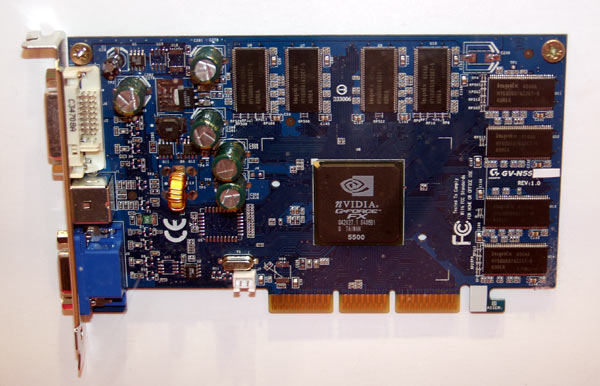 Gigabyte GV 55128D (FX5500 AGP) Gigabyte's FX5500 is produced in two makes. Make 1:
Make 2:
Another representative of today's popular mid-end line - FX5700LE. 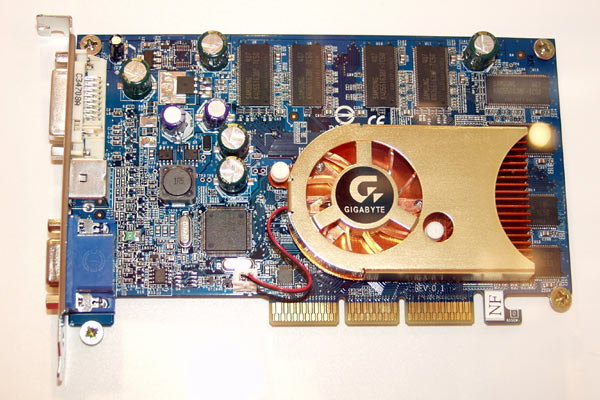 Gigabyte GV 57L256D (FX5700LE)
Then there go novelties made with the PCI-express x16 which before the release of Alderwood and Grantsdale will still be an on-paper announcement, since there is no place for them to put, and therefore they won't be sent to sales. Generally, this is the eternal "hen and egg" problem. To migrate to these new platforms, 4(!) factors at a time are needed: new motherboards, video cards with the PCI-ex bus, and the DDRII memory (or at least the Grantsdale in the make for regular DDR). But many forget that P4 Prescott itself with its new LGA775 bus has also not been announced yet, and that will happen most probably on the same day when Alderwood and Grantsdale chipsets are announced. Otherwise, there is no point in all that. At least by now video card manufacturers are absolutely ready to new times and if there is a demand, they would immediately get solutions like these: 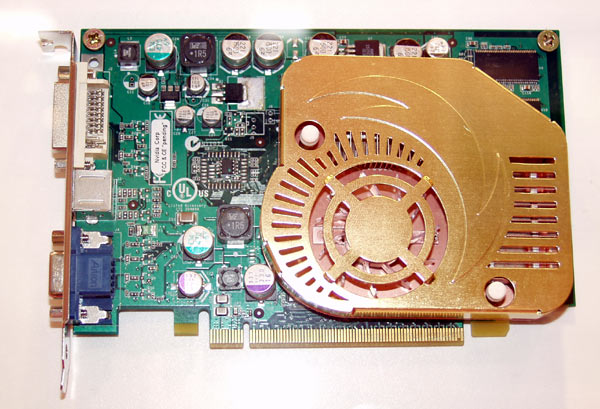 Gigabyte GV N53128D (PCX5300) Or, like these: 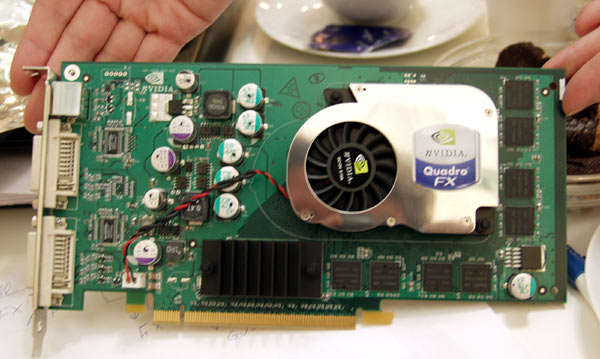 Gigabyte PCX5900 front 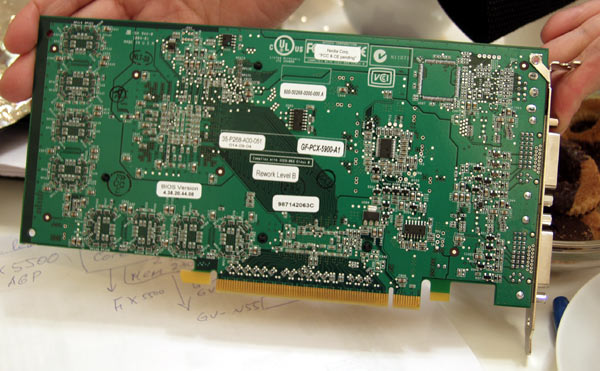 Gigabyte PCX5900 back I must admit I don't know how to comment this card I was shown by chance over a cup of coffee.. The thing is that Quadro professional video cards are made by NVIDIA itself (i.e. orders their production in a centralized manner), and judging by the textolyte this case is no exception. But sales are conducted by a few trusted partners. For example, the Quadro series sells on the European market under the PNY brand, and on the Asian market it sells under the Leadtek brand. As you see, all was divided long ago. Will there really be changes in the list of partners? The corporate market does not like changes... But anyway GIGABYTE should be congratulated on that :-) GIGABYTE coolersThere are two copper 3D Cooler models have been exposed by Gigabyte at CeBit.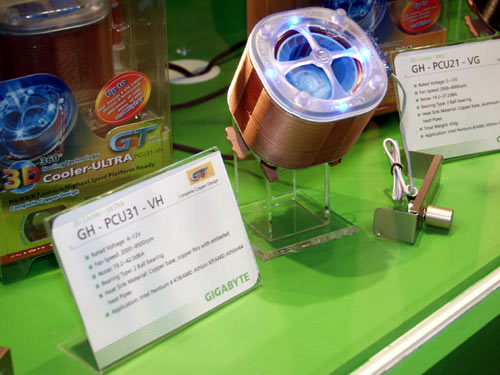 GH - PCU31 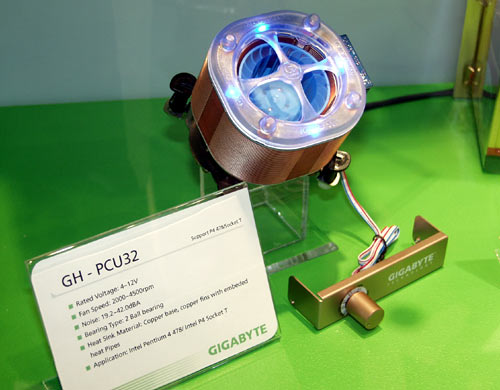 GH - PCU32 The only difference is about the height of the solution. So, what to say about them? Aren't they good-looking? :) But we can assess the efficiency and noise level only after tests. ASUS Expo StandAs is expected from the grandees of the industry, all the fashionable trends and undertakings are presented at ASUS expo stand, and even something unexpected... MoBoThe release of new generation Intel's chipsets results in a change of the numeric index on ASUS motherboards. With the current coding of model names, all is traditionally very easy. P stands for Pentium, the yesterday's four turned five, the third character A or G stands for Alderwood and Grantsdale, respectively; and D1, D2 are versions of the memory used - DDR or DDR2. Then, after the hyphen there go numerous letters standing for a specific design item and package bundle - that is afterwards, but for now only the generic models, or predecessors of product lines are presented. The coding of names is very sensible. ASUS has always been good at marketing, unlike some Taiwanese companies which treat this word as a curse. ASUS' Alderwood is presented by the generic model, P5AD2. Perhaps, it doesn't make sense to repeat that it is LGA775, dual DDR2, PCI-ex, High Definition Audio 7.1 (Azalia) audio. But unlike Gigabyte's higher-end model, ASUS' Alderwood offers a version of the south bridge with integrated RAID, but not the Wi-Hi of the outdated "b" version. Perhaps that may be right. As regards using RAID, I keep repeating it - there is no other technology that is so favorable to "finger sensitivity to the system response times". You can go on fitting an increasingly faster processor, build up memory capacities, switch to the DDR2, but anyway the speed of access to data recorded on these magnetic plates invented still in the year one has been and still is a bottleneck for the modern computer system. Isn't it a stone age!? But now you can buy a couple of hard disks (quite affordable thing with their current prices), mount a correct RAID array and even the old system will get the second wind. Do not ignore this good chance. I would recommend those especially timid to fork out for four disks and add the fail-safe backup feature :) In the Grantsdale sector, ASUS offers both options for the DDR and DDR2. They are P5GD1 and P5GD2, respectively, although there is still no "consolidated" option. And here comes the "interim" version especially for the happy owners of expensive processors and 1GB dual-channel RAM who wish to switch to a new chipset. Take a look at Grantsdale-P with the good old Socket 478 :-) This way, you would only have to upgrade the video card. It's a pity neither Grantsdale nor Alderwood offer simultaneous support for PCI-ex and AGP like, for example, the future K8T890 chipset by VIA. But 90 nm Athlon64 with support for DDR II are promised for only the end of this year. The lag is quite essential, and this will negatively affect the sales volumes of DDR II and thus their prices. For now, Intel alone will have to take the whole burden of promoting the new memory around the market. On the other hand, the new Socket 939 Athlon64 is presented at the expo as normal working processors despite all the rumors about delays with its release. For example, here is what is there at ASUS expo stand: But the clock speed is not disclosed, and the memory on the motherboard is definitely the regular DDR (VIA K8T800Pro chipset + 8237). This novelty will be available on sales in about a month, like motherboards for Socket 939. By the forthcoming Computex (1-5 June), both Intel and AMD are expected to complete migration to new chipsets, on which we congratulate us all. VGA ASUSIn this section, we'll restrict only to the photos of new PCI-express versions of video cards built on NVIDIA chips. It's strange, but no ATI RV380 samples like that at ABIT and GeCube stands were found... ASUS now is a favorite partner of ATI. 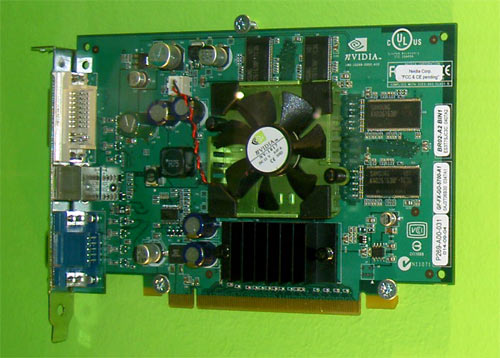 ASUS N5750 - a PCI-ex analog of FX5700 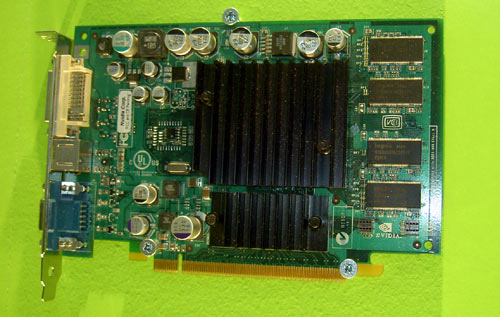 ASUS N5300 - a PCI-ex analog to FX5200 Having started in the mid-end sector with its smashing FX5700 Ultra featuring support for DDRII and easily beaten its competitor Radeon9600XT, NVIDIA slackened the reins and is treating creative findings of partners who started supplying tens of FX5700 makes with more piety. Some started fitting regular DDR memory on the Ultra chip, but 256 MB, there are makes with support for DDR3, some started varying the memory bit-rate, plus those LE and XT of whatever brands ... with misleading frequencies and number of pipelines, plus Ultra and non-Ultra.. But, recall the FX5600 series of the past summer with their absolutely different core versions.. it is also in the same range. Help! :-) ATI has merely four makes in this sector: Radeon9600XT, Radeon9600Pro, Radeon9600 and Radeon9600SE. Plus two cards from experimenters - GeCube Radeon9600XT Extreme (the memory frequency increased by 100 MHz) and HIS Radeon9600XT IceQ (the memory frequency increased by 50MHz). ASUS restricted itself in adding to the product line and presented the only but earnest card - FX5700 non ultra: 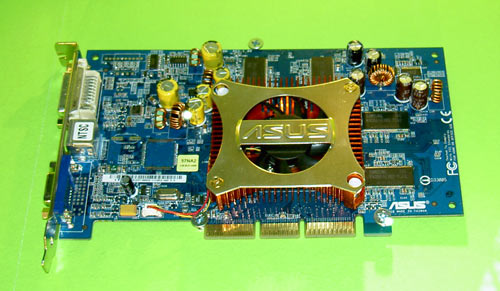 ASUS V5970 (FX5700) ExoticsWhatever you do with the wolf, he anyway keeps looking at the woods. The same is about ASUS: having pressed down the motherboard market, it is persistently striving to enter the consumer electronics market. Frankly, nobody, especially competitors, is waiting for them over there, and exploration of any occupied lands is sometimes more costly than the resultant profits. Therefore, new markets have to be established... and sometimes it works quite successfully, e.g. the birth of Internet ;-) All the traditional publishing monsters of Russia and other countries let this opportunity slip by and only now are getting aware that soon their role might be as important as radio versus television. So many times some smart people kept talking about the fatal consequences of missing "the key opportunity", but no way - that was all useless :-) 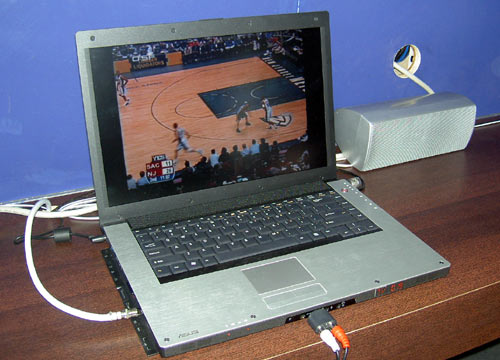 16:10 Widescreen; ATI Radeon 9600; Wi-Fi(g); Stereo 4.1 Therefore, a full-featured TV-set on the base of a remotely-operated notebook PC offering programmable recording or TV programs, whatever Wi-Fi features, 4.1 stereo sound etc. is an absolutely new product. But I can't understand how to create a market for it, when a regular TV costs 100-200$ and the rate of return was destroyed as far back as ten years ago (60% of SONY income comes from PS2, and the company is so scared of losing its leadership on the market of TV-boxes). Perhaps, from ASUS part it's merely an experiment, or maybe something more than that.  TV program No. For example, in Taipei at the "Agora Garden" hotel still in September last year there were 99 free TV programs, which turned to 120 later in January. With our 18 TV programs in Moscow are simply unaware of the daily needs of the average person living in a civilized city of the 21st century. Maybe it's just the very device the person is dreaming of while sitting somewhere in California or Hong Kong, where there is neither snow nor corruption, where police returns lost things, where everybody pays taxes and medical insurance etc. etc. things which our Soviet mentality can't accept. Unlike the numerous multimedia and TV-sets, ASUS is a notable player on the PDA market. Meet their new model at stores soon: 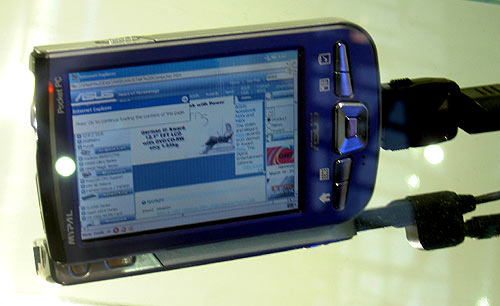
Coolers and PSUsASUS has produced coolers bearing the company's own label for many years even without making much fuss about it. I would easily believe that half the employees of ASUS have never even been aware of that. Probably they were seriously offended by the powerful initiative from their close competitor, and ASUS was downright angry. Even Zalman who for the past year have done nothing new and presented nothing else than external sound cards may turn green with envy about such a powerful line of coolers announced at the expo... Yahoo!!! Zalman!!! It's always easier to miss a brand than hype it up. No more help you in future :) 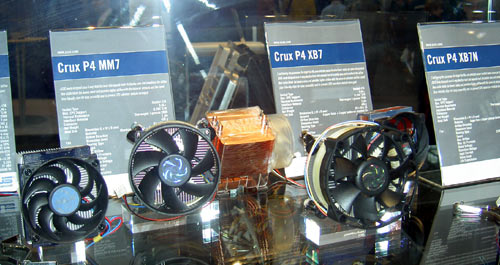 The new "Crux" product line 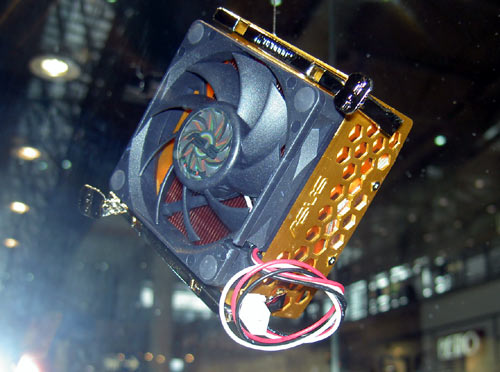
On the face of it, these are quite decent modern solutions, without any modding luxuries. But the PSUs took us by surprise. First, by that they appeared :) and secondly by that they meet the demands of the most exigent modder. Here is the illumination, and the so familiar logo, and the active cooling (in the sense that the cooler blades rotational speed is controlled automatically) and the 400-500 W power enough to cope with modern processors. All in all, the way it should be. 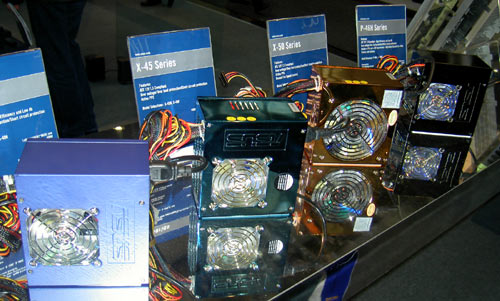
These guys have worked for quite a while with housings, so the only thing left for them is to produce a processor of their own and memory under their brand (which is easier), and - here you are - meet a complete solution from ASUS! MSI Expo StandMoBoThe MSI expo stand presented two novelties for the Socket 939: 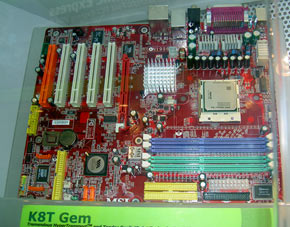 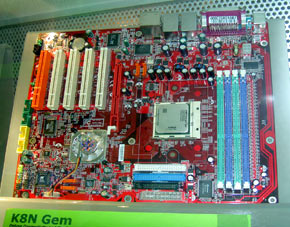 MSI K8T Gem (VIA K8T800 Pro + 8237) & MSI K8N Gem (nForce 3 Ultra) Both the chipsets are vividly outdated still before their release. Apart from support for HyperTransport with the bus speed as high as 1000 MHz, there is nothing new. That is, all is ideal for upgrade and will gain popularity - just replace the processor (Socket 939) and the board. and the remaining will be fine. But for a new modern system with a margin for the future, neither K8T800 nor nForce 3 Ultra will no longer work. We would have to wait for VIA K8T890 which seems to be bringing many surprises. Traditionally, all is going well with motherboards for Prescott and Tejas: 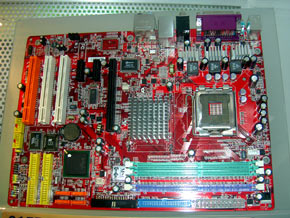 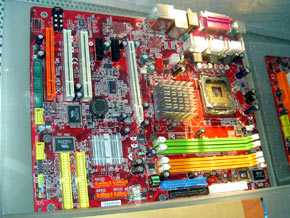 MSI 915P Neo (Grantsdale-P DDR400) and MSI 915P Apex (Grantsdale-P DDR2 533) As we see, both versions of Grantsdale-P have already been prepared. Even more than that, there is the rare guest Grantsdale-G with Intel's integrated graphics. It's still undisclosed what is really new in it - probably the DirectX version number has been increased to 8.1... it's high time, isn't it? Or Intel might lose its first place among the vendors of integrated graphics. Albeit honorable, the place is somewhat dubious. No one has even done any statistical analysis of whether this graphics core is used or there is an external card nearby. 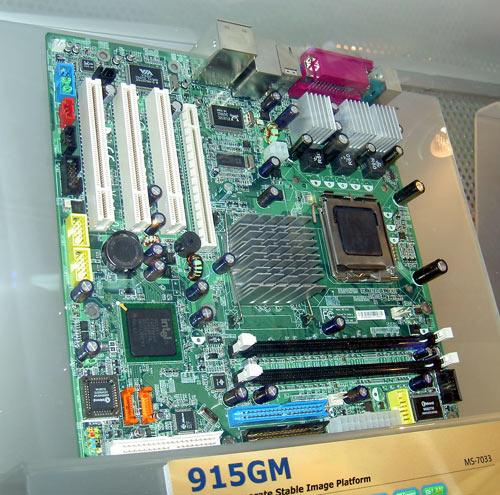 MSI 915GM (Grantsdale-G DDR2 533) The MSI 915GM card arouses vague suspicion as to if that is an Intel's reference board. The color is strongly nonstandard for MSI produce. Probably the original version of MSI is still in the development, and for a while they just hastily placed the reference. It is highly probable in view of the fact that Grantsdale-G is presented at the expo is very small quantities, and on top of it all his one uses DDR2 533! Isn't it a queer decosion to fork out for DDR2 (which is twice as expensive as the regular DDR) and save on a video card? And lastly, the prima donna Alderwood of MSI: 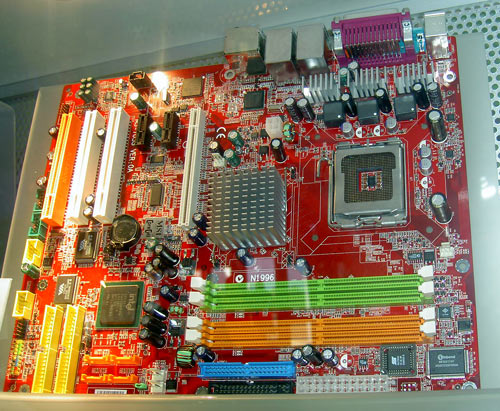 MSI 955X Apex (Alderwood DDR2 533) Initially, such cuties will cost at least $200, but recall the first i875 motherboards. And considering the traditional rich package bundle of MSI, it's going to cost as high as 220-240$. We have already covered almost all about the chipsets what we knew, so we are not going to list the details officially pronounced already. If there's an announcement, there will be details. But there is one fune point that needs to be clarified. If you look closely at all the photos of MSI motherboards presented on this page (except those on Grantsdale-G, which once again proves that the board is still Intel's reference), then you'll see the orange colored PCI slot that takes some place at the edge. This slot is meant for the MSI communication riser card that offers simultaneous support for Bluetooth and Wi-Fi(g). So, MSI is unlikely to use the ICH6/W version of the south bridge for Intel boards - they all offer the R version. The board itself was found at one of the "live demo" stands: 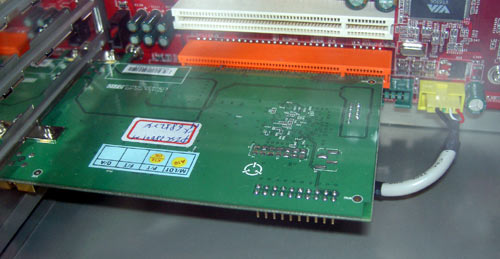
But where on earth are those PCI-express x1 expansion cards with such a tine contact pad? As the company representatives repeatedly said to use, they were "under preparation". 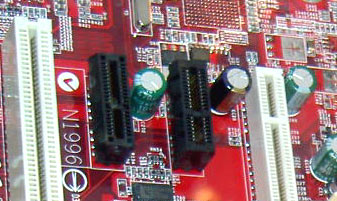 PCI-express x1 "They will appear once new motherboards hit the retail". Anyway, I wouldn't like to have it all over again like those numerous "proprietary solutions" which finally haven't proved to gain any popularity despite numerous attempts of their introduction. The dimensions of PCI-express x1 cards will be much smaller than the existing PCI devices, and it looks like the same road on the way to introducing the future BTX form factor. By the way, no one at CeBit has demonstrated the BTX platform. Perhaps still too early. MSI VGAThe first what you notice at the video stand is the option of FX5700 Ultra featuring DDR3 memory: 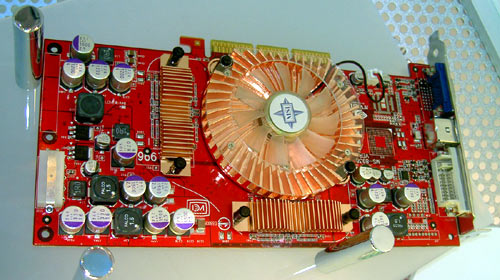 MSI FX5700 Ultra 128 Mb DDR3 Funny, isn't it? :-) DDR2 is just about to be introduced on motherboards, but the video industry is already exploring the DDR3. nVidia was the first to attempt using the new memory type DDR2. Recall the forgotten NV30 project which proved to be a pioneer both at the number of innovations (0.13 mk, DDR2 etc.) and at the first commercial failure of NVIDIA (to be more tedious, the first failure was that with NV1). But pioneers are commemorated, and memory about them is embodied in monuments. The DDR3 started its approach with the proven solution - FX5700 Ultra, as a version of its make. If the market accepts it due to the price or whatever, well, let it be so. No one will be much indignant about that. That's what an experiment is for - to acquire experience in unknown areas. So far, DDR3 hasn't been used in consumer solutions, but it is often used in communication, scientific and professional equipment where the price is not the most important. We believe the introduction has started ;-) I must admit, my hands are itching with desire to add the results of testing this video card into our "VGA Roundup". 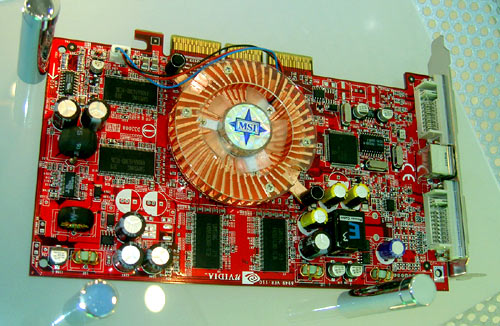 MSI FX5700 256 Mb DDR The other novelty of those which could be ready put into the slot is MSI FX5700 non ultra offering 256 MB of regular DDR. All MSI cards are shipped with the declared support for "Unleashing Dynamic Overclocking Technology" - MSI's proprietary technology for safe core overclocking: 
And the expansion over to the middle-level AGP market ends with the "light-version" MSI FX5700LE card:  MSI FX5700LE 256 Mb DDR Then there go only PCI-ex solutions. Reminding it that the maximum bandwidth of the new bus is merely 4.0 GB/s, whereas AGP-8x offers merely 2.1 GB/s. For now, only the top-end card are reaching such heights. 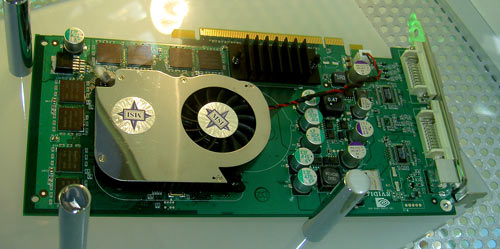 MSI PCX5950 PCI-X 128/256Mb Interestingly, there is no cooling on the memory, but on the AGP->PCI-X bridge a radiator is always there. 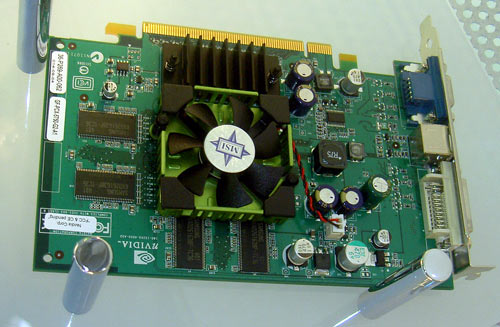 MSI PCX5750 PCI-X 128/256Mb And the last of the PCI-X line is the FX5200 analog dubbed PCX5300: 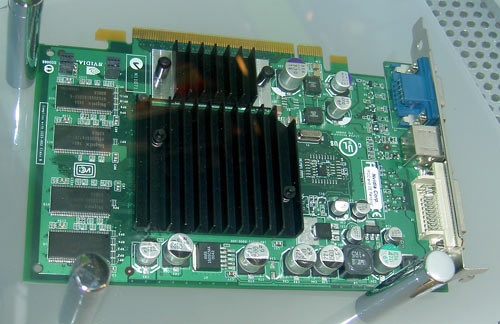 MSI PCX5300 PCI-X 128/256Mb But where are the future favorites - ATI R420 and NVIDIA NV40? Still in the samples and are not demonstrated openly. You can hold NV40 in your hands at the MSI stand, and only during certain times and by appointment :-) 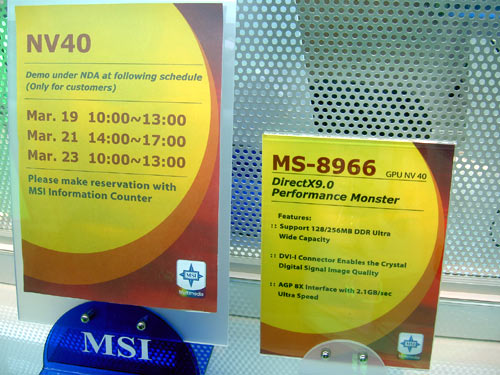
MSI storageThere are some really interesting novelties of the storage world. First, optical drives have acquired the SATA interface, which is indeed convenient and will allow to get rid of the old cables in the system. 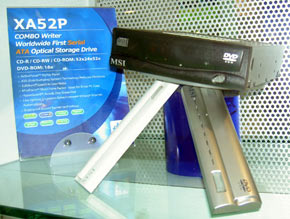 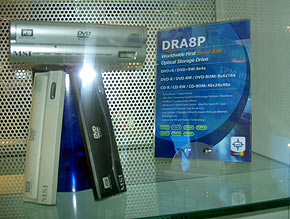 XA52P (combo) and DRA8P (DVD+R/+RW/-R/-RW CD-R/RW) Another curiosity - "Mega Cash", a miniature USB storage based on a 1.5 GB hard disk without additional power supply. A really light and truly miniature thing. It's a pity I didn't put a cigarette box - the storage device would easily fit inside it. 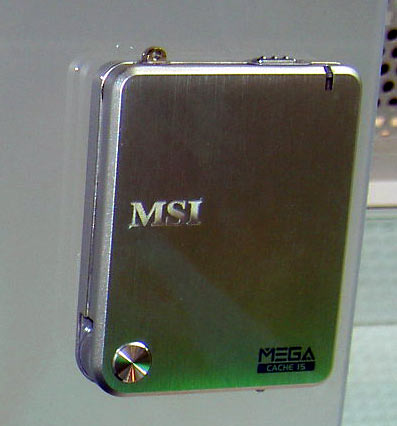 MSI Mega Cash: USB2.0, 1,5Gb ExoticsThis is a product of the "new markets" category, or no analogs so far. Everybody knows portable DVD players by Sony, Sharp, Panasonic etc. quite well... But who on earth would need a product costing $1000 to view DVDs in the stereo mode on a small screen? The quality of Mpeg2(DVD), Mpeg4 and even AVI formats is hardly distinguishable on such screens. That's what MSI just looked closer upon and produced the "Portable AV Player". The current capacity of the hard disk is 20 GB. The Mpeg4, AVI, Mp3 formats and viewing photoalbums are supported. This capacity is enough to store 15 films, or about 4000 songs in the MP3 format. A really nice thing! 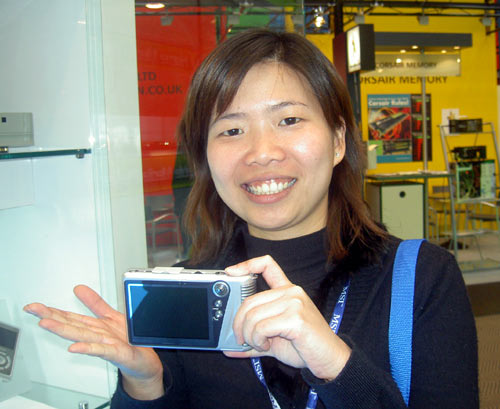 Rita Chiu demostrating the "Portable AV Player" We asked to switch on the device and demostrate the image quality: 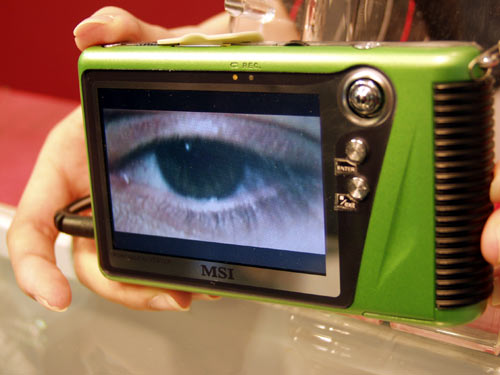
NotebooksThe first was ASUS, then there goes Gigabyte, so MSI couldn't help releasing its notebooks, which is absolutely evident. 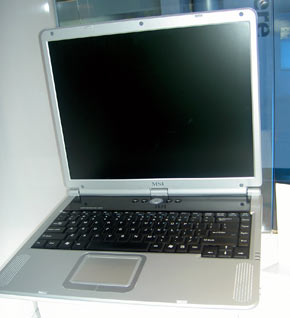 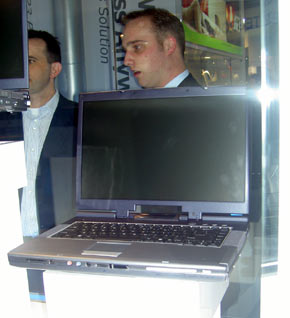
There is still no my dream "tiny" reporter's subnotebook, sort of the Asus' Centrino, and the whole line is gathered in two models "regular notebook" and "widescreen notebook". They are somewhat faded and indistinct. That seems to be about all what to say about them. In Russia, notebooks like these won't come to sales - we have got our own brands without others. With all the well-established technical support, reasonable price and even guaranteed upgrade. The start has got to be successful. The way to make competitors shattered, but with these notebooks MSI is very unlikely to ever see the Russian market. Video cardsHISThe company is a true adherent of ATI, and is not going to produce video cards on NVIDIA chips at all. It also one of the first companies who changed the frequency on its "Radeon 9600XT Turbo" from standard 600 MHz to 650 MHz.. 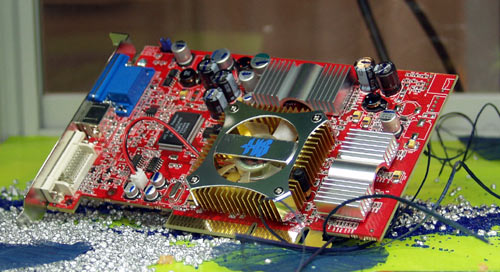 HIS Radeon 9600XT Turbo You would ask - what's so big about it? For ATI products, it is quite a deed. ATI hates departure from the canon. Even Sapphire who released SE cards cut down in bus bandwidth was almost excommunicated and even fell into big disgrace. ATI was so infuriated that even bought back the control stock of CP and handed the production over to them (I didn't tell you about that.. :-). Still up till recent times, HIS products was listed in Russian price-lists as a "noname product", to no purpose indeed. Those Hong Kong guys have been around on the market for a hundred years and are in big favor in the South East Asia. Recalling Radeon 9800Pro cards looking like twins (and manufactured at a CP factory), we can note the only thing that falls outside the row - Excalibur Radeon 9800Pro IceQ, where "Excalibur" is a trademark of HIS video cards, and the "IceQ" is the name for their cooling systems. 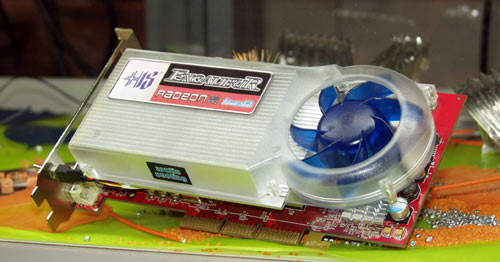 HIS Excalibur Radeon 9800Pro IceQ What's going on? Now partners are divided into primary and secondary. The secondary are those who deal with all the manufacturers of video chips. It's just they who might be the sources of information leakage to competitors regarding release dates, frequencies, innovations etc. the key data about future products. Therefore they are provided with pre-ordered number of new cards for initial familiarization with new produce. Top-end cards are extremely difficult in production, and their quality requirements are very rigid. Plus their sales do not make up more than 10% of the whole video cards market. It's extremely prohibitive to divert their production at tens of factories. Another thing is the mid-end and low-end solutions which need to be produced in millions of pieces. At that, partners are allowed to make use of their technological tricks and experience: for ATI cards, it applies mostly to boards redesign and use of cooling systems, whereas for NVIDIA it can be applied to whatever. The secrecy on such perishable product market like video chips is the key strategy. No one will ever make their GPU structural diagrams, even for outdated solutions, unlike Intel and AMD who work at a new core normally for three to four years. Hunting for the competitor secrets and keeping own secrets intact is the daily concern for any business. Can you imagine how XGI is now hunting for the ForceWare and Catalyst source codes? Adapting other developments to your own architecture is twice as easy rather than bringing hundreds of games from the archives to light, verifying them for operational stability and solving the issues that arise with your own sweat and blood. It may take about five years when XGI can finally create something worth of Catalyst, but during all these years they will be behind the scene albeit having the super exclusive core and excellent scaling technology which is available at them for real. A few notes on the scaling. From the very first chip, 3dfx (let them be remembered for ever) was absolutely right considering the opportunity - the interlaced image processing made by each video card gave a two-fold performance gain. In its passed away MAXX series of video cards (two chips onboard), ATI in the end failed to make the driver work correctly. With the acquisition of 3dfx by NVIDIA, the latter acquired all their developments including those to do with multi-chip cards, just what they were working at on the threshold of their demise. The question is still open: does NVIDIA really have a grand piano in the bush in the form of multi-chip configurations, and if yes, is the company going to implement them eventually? Is such technology being considered by ATI as a margin for performance increase and as a means of moving computer graphics closer to solving the photorealism problem which is still a very long way to go? Another approach may be in the use of multiple cores of the graphics chip, i.e. generation of several (two,four) full-featured GPUs on a single chip. At least, Intel has already declared its migration towards multiple cores, thus completing the logical chain: HT (multisequencing of operations on the level of a single core), MCore (multiple cores on a single chip, each supporting HT) and SMP (symmetrical multiprocessing of these multi-core monsters). Of course, implementation of this idea will require a revision of today's programming ideology, programmers' mindsets, creation of new programming tools etc.. Our beloved graphics fanciers, ATI and NVIDIA, do not possess financial resources of Intel for such industrial revolutions and are most likely to sit safely under the cover of their environmental niche, content with just another duplication in the number of pipelines per chip with simultaneous migration to finer process technologies. But sooner or later they will inevitably come up against the physical limit of the crystal lattice! This time may come in about five years. Well, who knows what may be in about five years :-) Maybe VIA and hot Finnish guys will rule solving further problems of graphics multi-core architecture and multiprocessing jointly with developers' companies... AbitAt CeBit'2004, Abit announced their first "Volary DUO V8 Ultra" card. 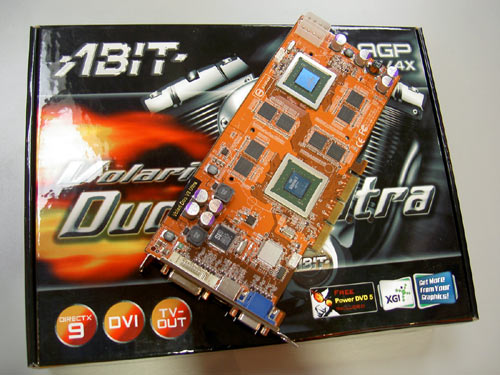 ABIT Volary DUO V8 Ultra 256Mb DDR 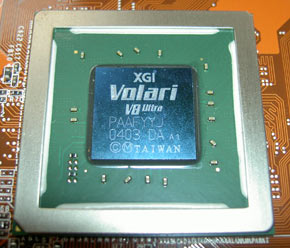 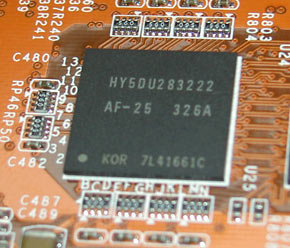
Is it a reference from XGI? Not really. The reference looks quite different: 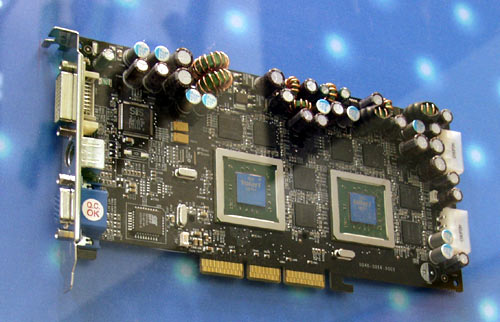 XGI Volary DUO V8 Ultra 256Mb DDR That it would happen we informed still on 3 February, and were right :). Also in February, there was an announcement of ABIT cards made on ATI chips. Even more, the secret RV380 found some space at ABIT expo stand: 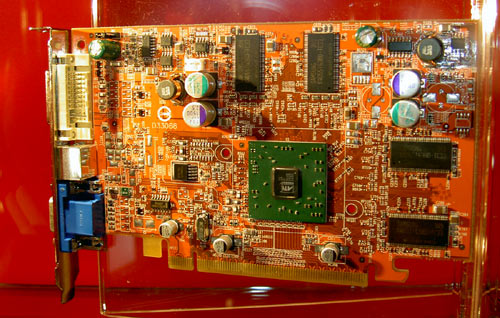 ABIT RV380 And in so doing, the company does not intend to cease its cooperation with NVIDIA. Inscrutable are your ways, Lord. 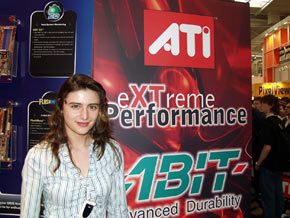 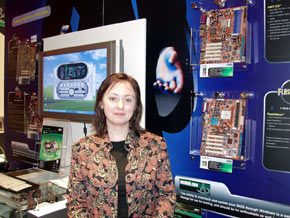 Vika (Abit, Taiwan) and Anna (Abit-Moscow). How lucky you, ABIT, are with pretty Russian ladies! Currently, ABIT is holding its first international championship. The cyber-sport is on the up and is emerging from the shabby basements to the bright light. In South Korea, there works a round-the-clock channel.. Following the example of Samsung and LG, champions are winning prestigious cars and earn hundreds of thousand dollars prizes for their teams. Not millions yet, like it is in professional boxing or football, but something. And that's only the beginning. Russian cyber-sports team takes active part in ABIT championship. All the finalists are up to Shankhai once the June's Computex is over. Let's support the Russian united team! 3DNews is a media sponsor of the competition and we'll be publishing detailed coverage of the competitions straight from the events. Keep up with the news.. :-) ProlinkJust one more company that prefers its own solutions is Prolink. It produce (the PixelView brand) differs from tens of analogs by the proprietary PDFII/PDF cooling system and compulsory thermal control unit. If in its standard make it was placed onboard the card, now there may be a version with the system brought over to the front panel: 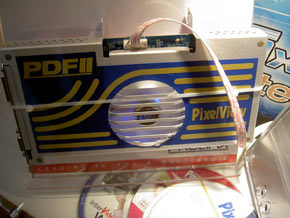 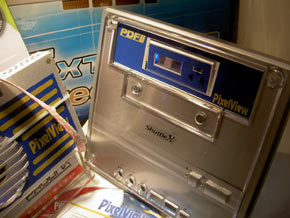 Prolink FX 5900XT Golden Limited PCI-E version of the PCX 5950: 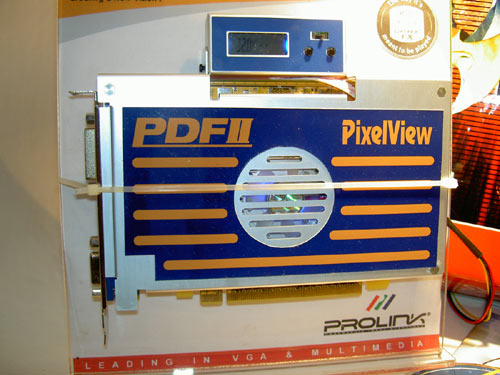 Prolink PCX 5950 Even PCX 5300 (analog of FX5200) with the PDFII cooling system looks like hi-end! There's something to show to friends. 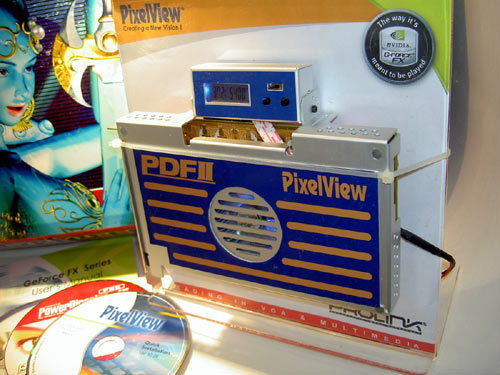 Prolink PCX 5300 Photo of the day: Cyberfight.ruZalmanZalman, Korea, has developed cooling devices for whatever components inside the computer. The company also presented its own PC housing for fully passive cooling to the public assessment. 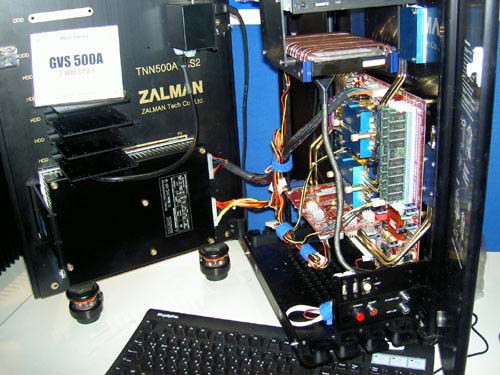
The housing weighs around 25 kg, has handles to carry it around, as well as wheels to transport it over the floor. The housing is equipped with lots of heat pipes which transfer heat from the processor, video card to the lateral walls which function as a big radiator. 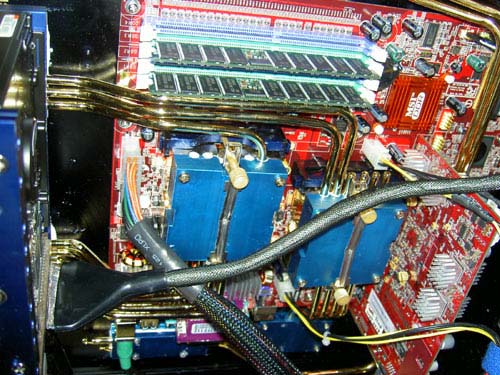
The cost of such solution exceeds $1000. Heat pipes are actively used in other company products: e.g., in the hard disk cooler ZM-2HC2 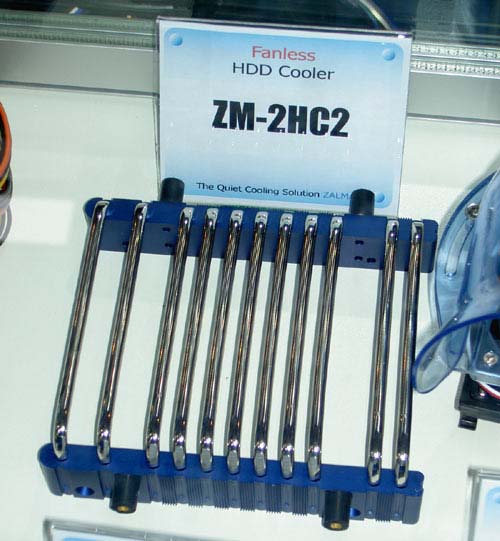
But since recent times, Zalman has felt too tight within the boundaries of PC housing and started developing external devices. For example, the company demonstrated a working prototype of the water cooling system. 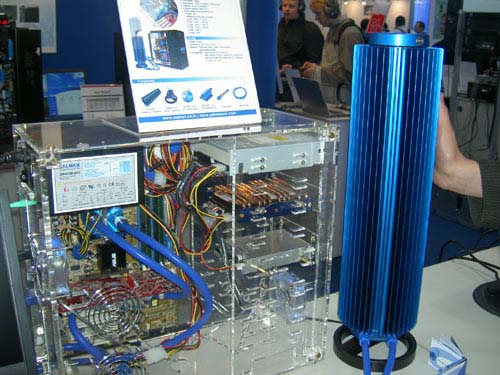
The huge tower functions a radiator to cool liquid. Actually, the system was demonstrated at the previous Computex, so we haven't seen anything new. But other external devices proved more interesting - primarily, because they are not meant for cooling. First, 6-channel head-phones: 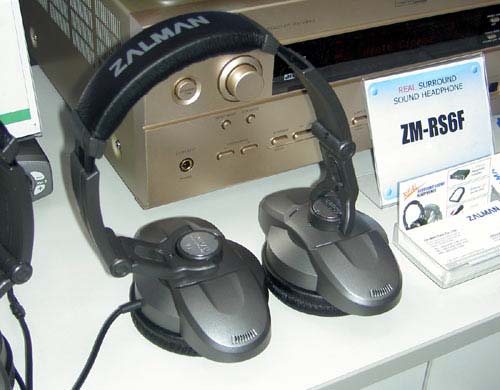
They can hardly called a novelty, since they have been long enough at retail stores. But the amplifier for headphones.. is something new. 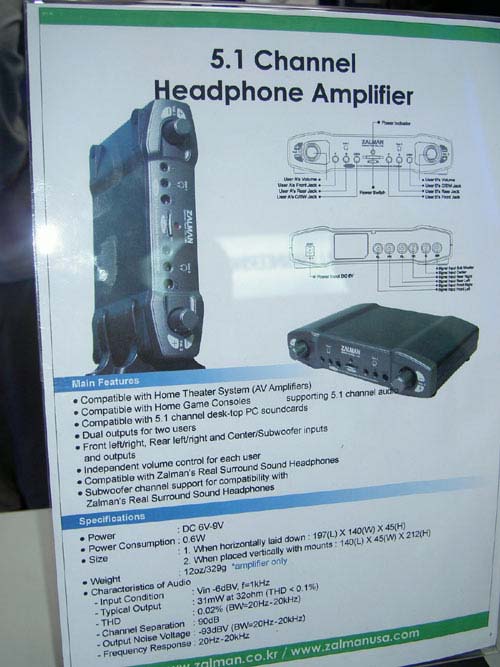
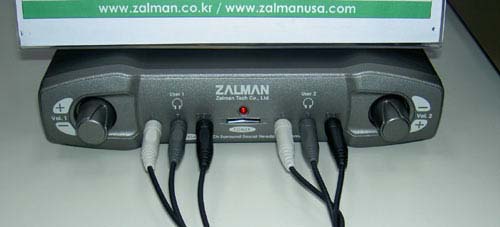
And to close the audio topic, Zalman presented an external sound card. 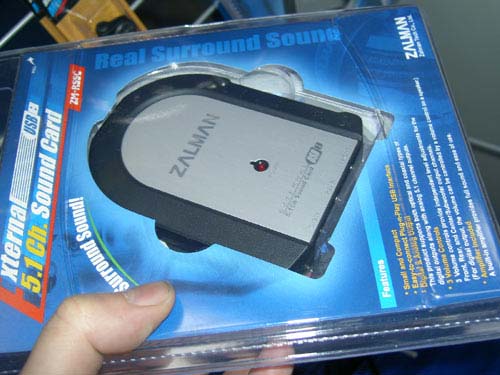
I wonder if Zalman is cool enough to produce video cards. Cooler MasterCooler Master presented new aluminum housings, thus expanding its already rich assortment. 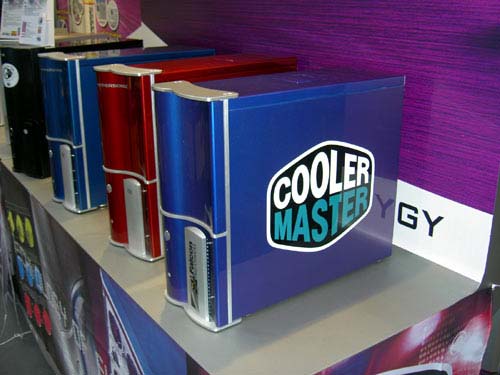
Attention was spared not only to the customary Tower cases, but the already out of fashion Desktop (as per the other version, squeezed out of the market by barebone systems :). 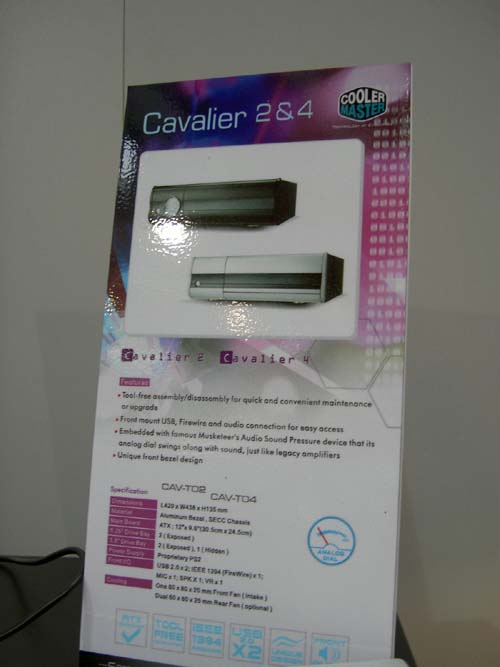
So, the company presented Cavalier 2 and Cavalier 4 housings. 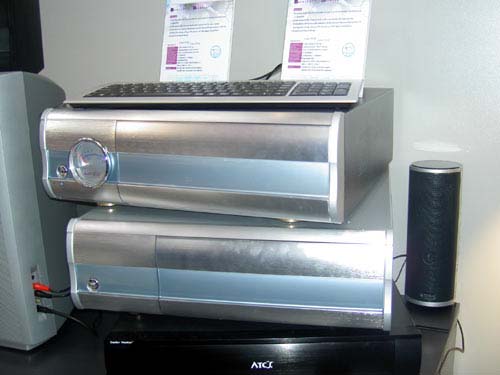
At first glance, they look very trendy. And to adhere to the style, Cooler Master offers an aluminum keyboard. 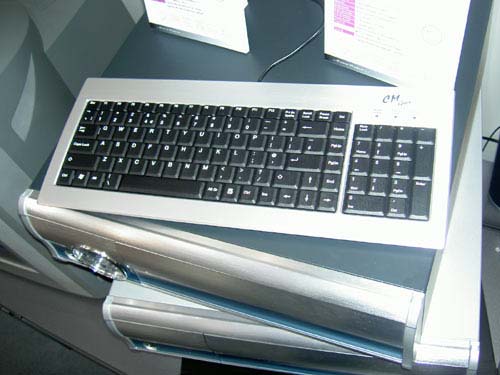
Another interesting housing offers 12(!) 5-inch compartments. 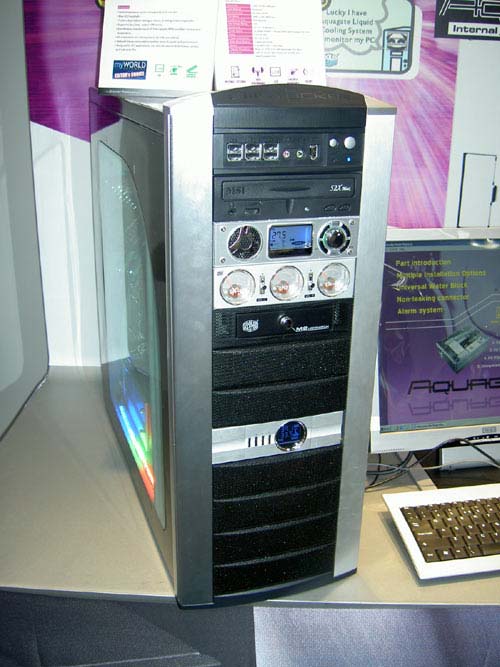
Interestingly, this case was used by Cooler Master to demonstrate a new generation of the Musketeer 2 panel. 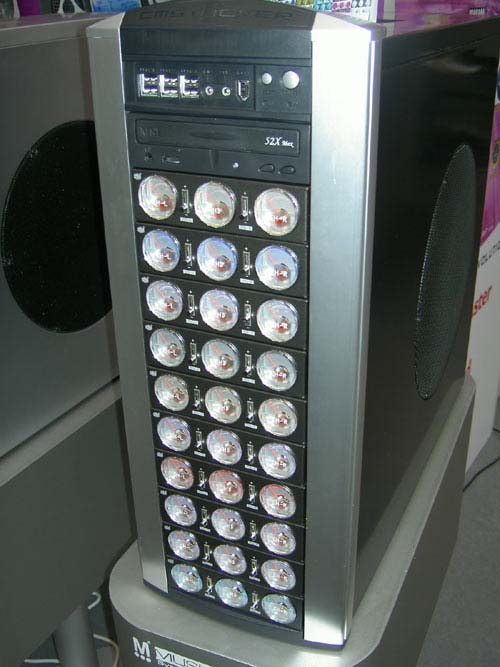
The company also presented a number of new cooler models, of which we took the most interesting. 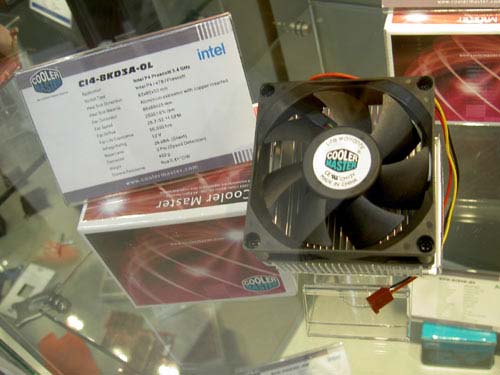 CI4-8KD3A-OL cooler for Intel Pentium4 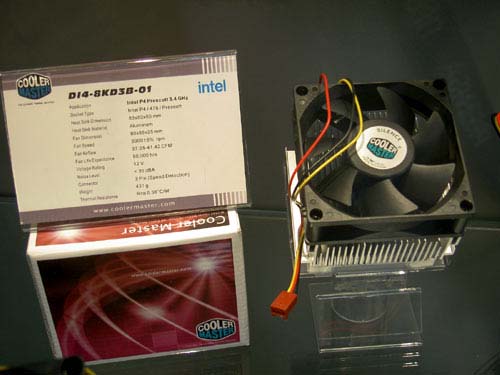 DI4-8KD3B-O1 cooler for Intel Pentium4 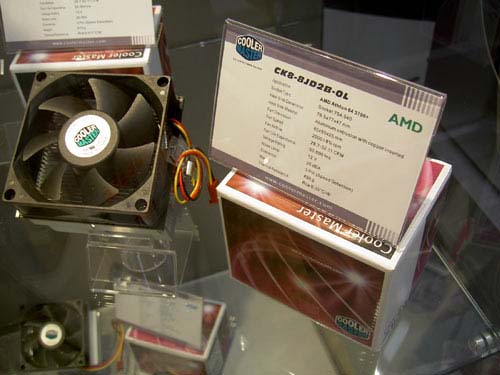 CK8-8JD2B-OL cooler for AMD Athlon 64 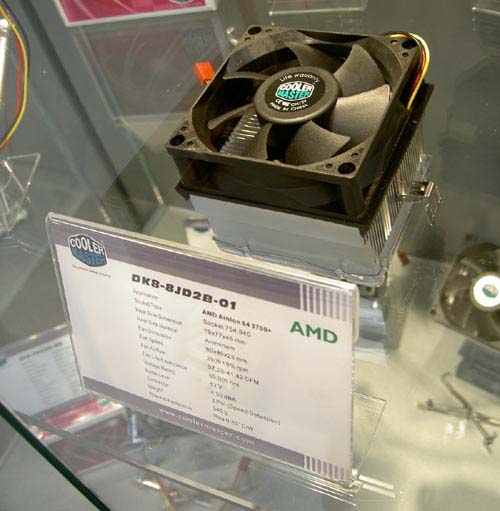 DK8-8JD2B-O1 cooler for AMD Athlon 64 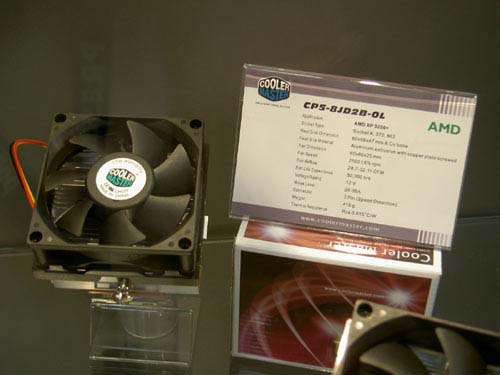 CP5-8JD2B-OL cooler for AMD SocketA 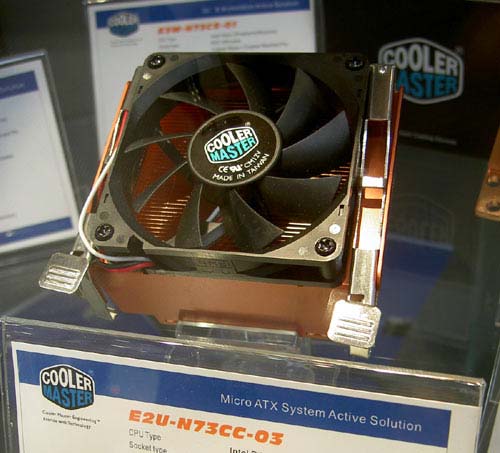 E2U-N73CC-O3 cooler for low-profile (U1) Pentium4 systems Cooler Master also presented solutions for cooling Xeon processors, 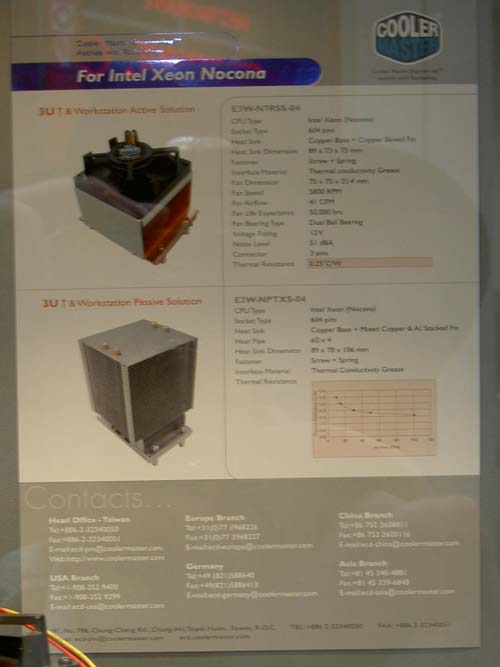
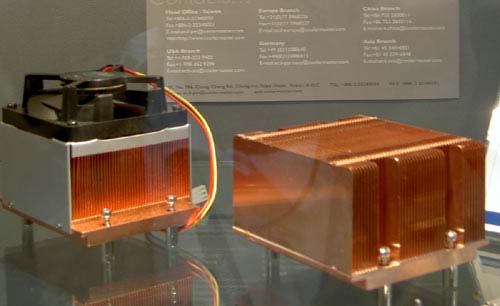
as well as coolers for PC enthusiasts: VortexDream7 and XDream II. 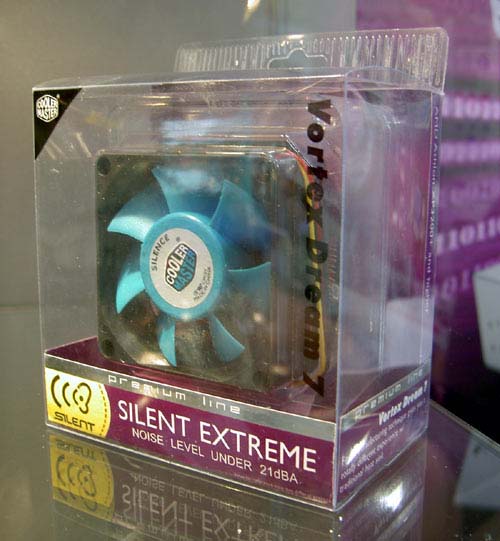
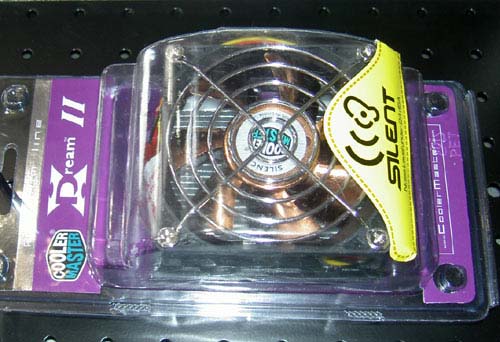
But the most catching exhibit at the stand was the Hyper6 radiator where six heat pipes are used. 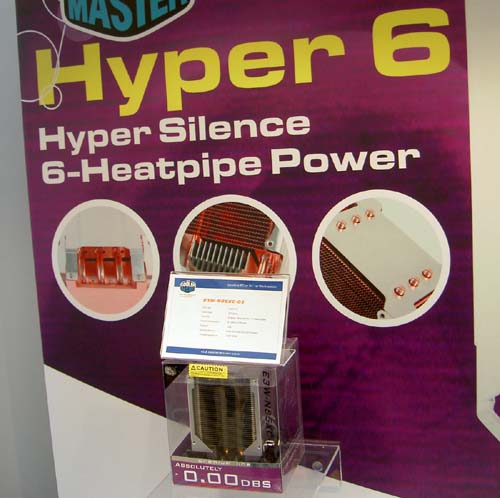
The radiator offers a giant surface area, and is able cooling weak and average processors in the passive mode. For powerful processors (and overclocking), you would have to install fans. The radiator is manufactured in several makes: there is a cheaper model with aluminum fins and four heat pipes. 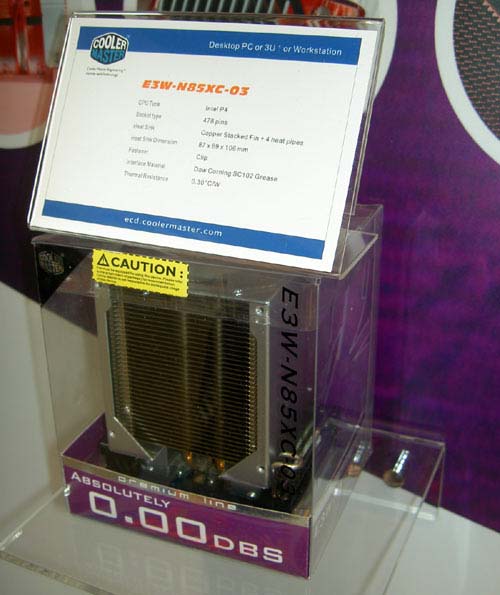
And there is also a high-end radiator with copper fins and six heat pipes. TitanAt the expo stand of Titan, the major role is played by air-driven coolers. 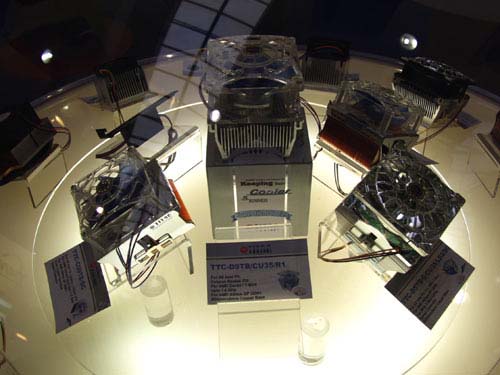
We have already tested most of them , and are not going to dwell on this section. We'll note only the cooler of quite an interesting design. 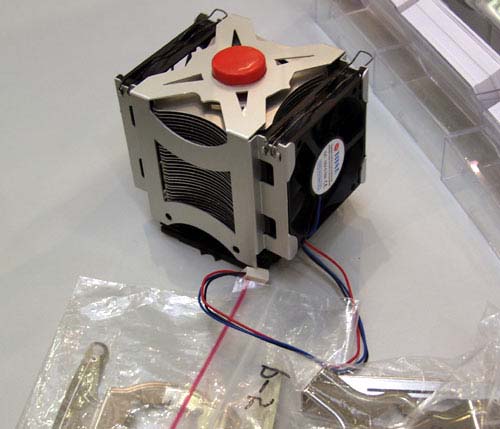
Of more interest are water-driven cooling systems. 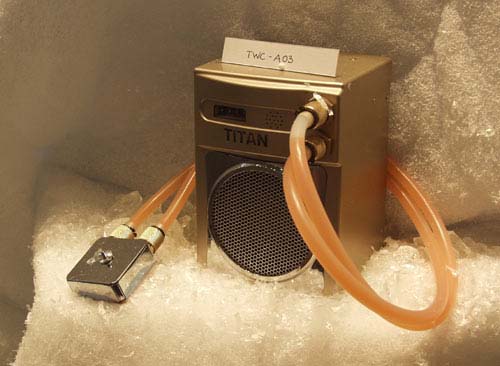
To all appearances, these are prototypes, since instead of the final specifications there were only cardboard pieces with the model name on :) . 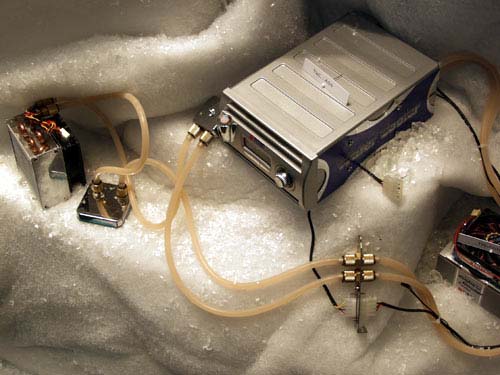
To demonstrate the layout of the system, a housing with transparent walls is used. 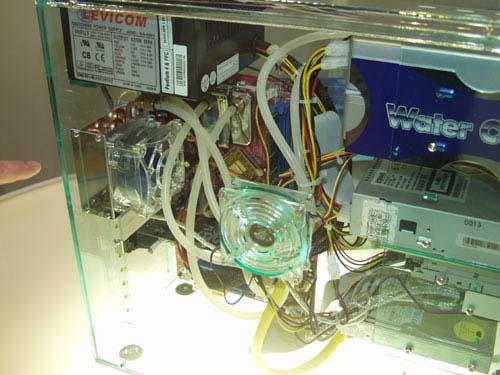
Another prototype: a huge aluminum radiator. 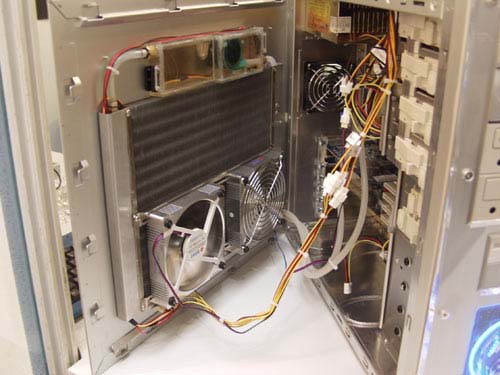
For now, it is still hard to say whether it will be a separate product, or a component part of some other system. At the expo stand of Titan, a great number of cooling systems for video chips is presented. 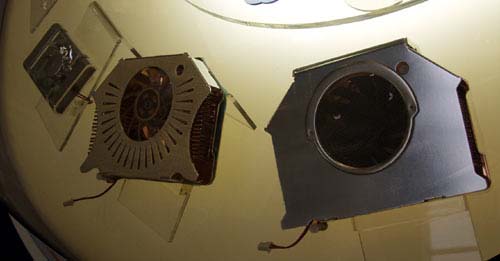
Most likely, these devices will be interesting to video card manufacturers. Because at first glance they all have an aluminum radiator, and a small (thus, speedy and noisy) fan. 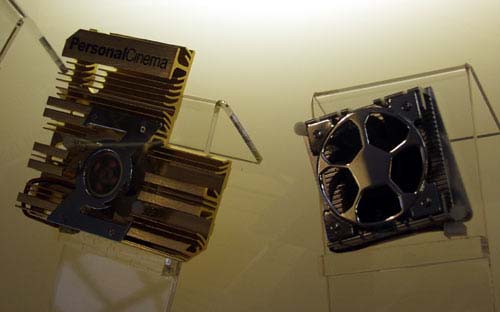
But computer enthusiasts are interested mainly in massive copper radiators with big low-noise fans. 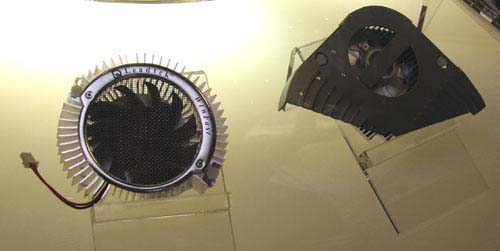
Another product presented at Titan stand is a cooler for external cooling of a video card. 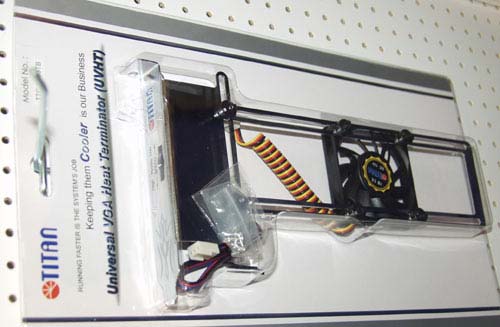
It offers a 3-position cooler rotational speed regulator. And the cooler itself is positioned on two guides which allow varying its location. Therefore, the user can choose the optimum cooler orientation relative to the video card (or another expansion card). SpireThis is another large manufacturer of cooling devices who presented a renewed line of processor coolers. 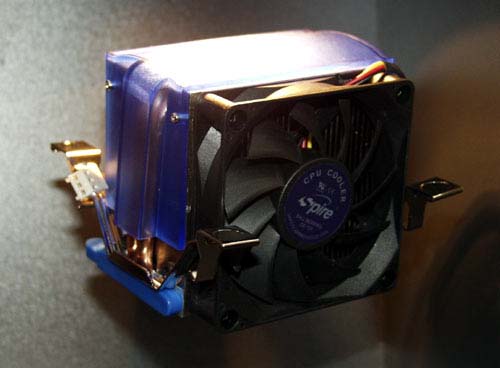
The assortment of Spire offers coolers for both Intel and AMD processors. 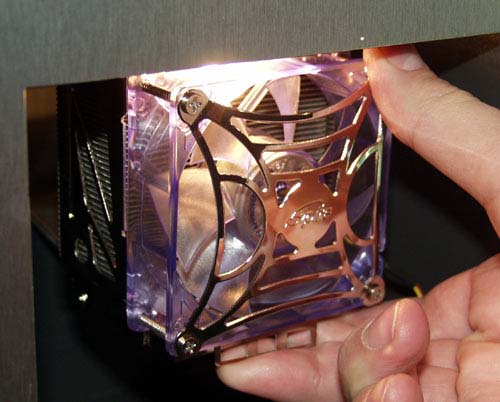
The cheaper coolers have an aluminum radiator, and those more expensive - a copper radiator. 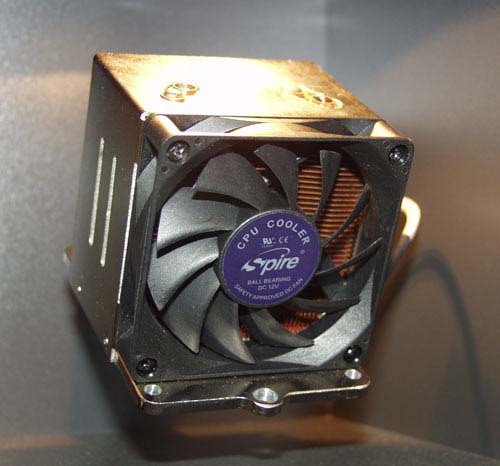
To make their coolers stand out among the mass of identical coolers, the company engineers use varied protective grids and fans with the case made of strong plastic. 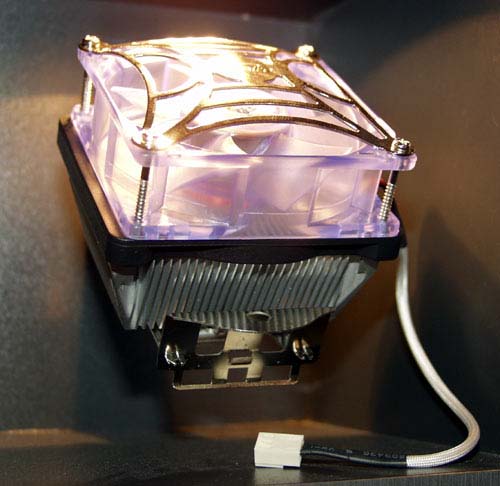
Some models come shipped with a rotational speed regulator. 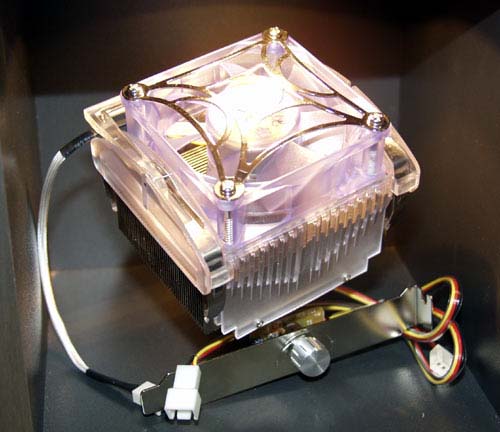
The computer enthusiasts may be interested in radiators sold separately. 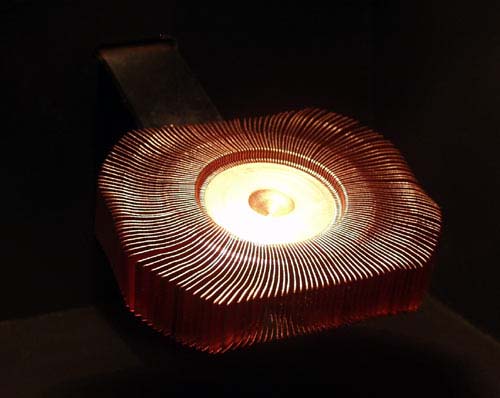
At first glance, it is a good quality product made fully of copper, of large surface area. In conclusion, we are bringing in some photos of the prototypes of cooling systems: 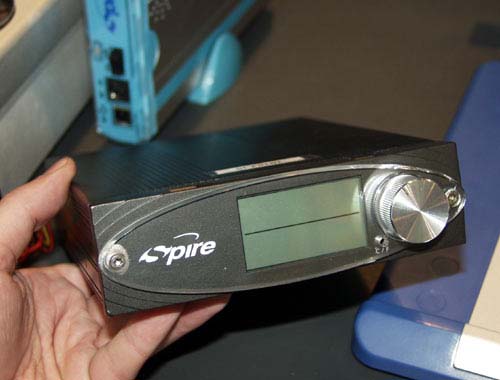
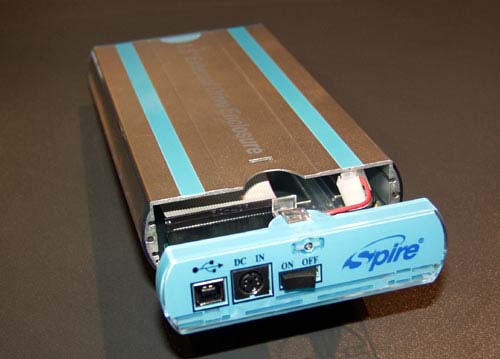
It's hard to tell something certain about the first two. But the third one is a small water-driven cooling system which is also under development. 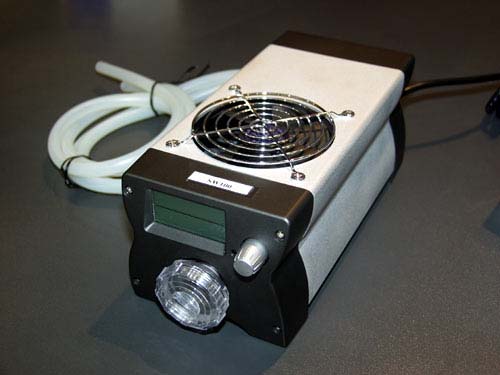
|
|
|||||